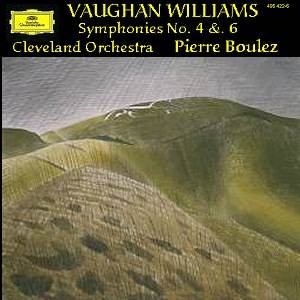An unusual
and rewarding release from the yellow
label. Although Vaughan Williams was
one of the great symphonists of the
last century, it has taken Deutsche
Grammophon a long time to record any
of his output beyond the Tallis Fantasia
and The Lark Ascending. Indeed,
until very recently, recordings of Vaughan
Williams' symphonies were by and large
exclusively British affairs; even when
taken up by non-British conductors,
like Previn and Slatkin on RCA, Haitink
on EMI and Bakels on Naxos, they generally
recorded with British orchestras.
Enter
Pierre Boulez. A long standing critic
of British music, that Boulez would
conduct Vaughan Williams at all is most
surprising. The grand old man was still
composing symphonies when the young
Boulez was spouting all sorts of anti-symphonic
rhetoric and establishing himself as
the darling of Europe’s avant-garde.
Perhaps DG held this recording back
for four years because of the risk to
Boulez's reputation. Symphonies with
a modal flavour from a tweed-wearing
Englishman must have been anathema to
the young visionary and would be expected
to remain so.
Age,
however, seems to have softened Boulez.
It is not a complete about-face, though.
Boulez may be conducting Vaughan Williams,
but he has chosen the most gnarled of
the symphonies, the most violent and
the most disquieting.
These
performances are informed very much
by Boulez's approach to Stravinsky and
Bartók. Rhythmic lines are stressed,
textures are clear and ensemble is perfectly
balanced. There is also little surface
emotion, a quality of distance that
can make Boulez's performances seem
cold. It is worth remembering, though,
that Vaughan Williams himself resisted
any attempt to cast these two symphonies
as war symphonies. The traditions that
have grown up around these two works
may make the Boulez interpretations
seem distant, but Boulez, perhaps more
than anyone else, allows us to hear
these scores as absolute music. Vaughan
Williams would have approved.
The
Fourth receives a fine performance.
In the first movement, Boulez's timing
is a whisker faster than Handley's and,
in fact, not too far behind the composer's
own mono recording. However, despite
the pace, ensemble is perfect and the
musical line is unbroken by any roughness.
The scherzo and finale fly by, curiously
without fire, but strong and impressive
nonetheless.
The
Sixth is a revelation. The crushing
opening screams are pounded out by the
orchestra and the downward rush that
follows never becomes confused or loses
its rhythmic centre. Boulez's control
here is extraordinary. Pointed rhythms
enhance the snarling of the second movement.
In the third movement the uncredited
saxophonist leans back on the beat and
gives the solo equal measures of jazz
and sleaze. It almost doesn't work,
but Boulez gives the soloist room and
he or she brings it off. The finale
carries the most hushed intensity since
Boult's first recording with the London
Philharmonic on Decca (also available
on Australian Eloquence). Boulez sees
this uneasily quiet music as an arc
and the Cleveland strings, with a genuine
pianissimo, support the through-line
admirably.
In fact,
the playing of the Cleveland Orchestra
is magnificent throughout this disc.
The Clevelanders have a fine pedigree
in British music. Szell’s Walton performances
remain among the most exciting on record.
The choice of the crack American band
gives the recording a different tonal
palette to what one usually expects
in this music. The string tone is consistently
smooth, even in the more vigorous passages,
and the brass has that bold American
quality that contrasts so strongly with
the brass-band influenced sonority common
to most British orchestras.
The
acoustic of the Masonic Auditorium is
a touch dry, but if anything this actually
helps to clarify textures at the climaxes
of the opening movements of both symphonies.
These can can often sound crowded in
more reverberant venues.
I would
not rank Boulez above my prime recommendations
in this music. Handley and Previn are
the benchmarks and Boult's classic mono
recordings of these symphonies remain
essential. Boulez is too unidiomatic
for his recording to usurp theirs. However,
as an illuminating alternative view
of these scores, his is very hard to
beat. The other continental European
to have recorded both of these symphonies
in recent years, Bernard Haitink, comes
off a pale second best.
Tim
Perry


